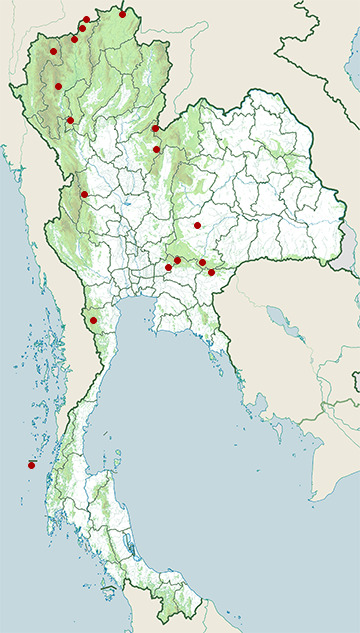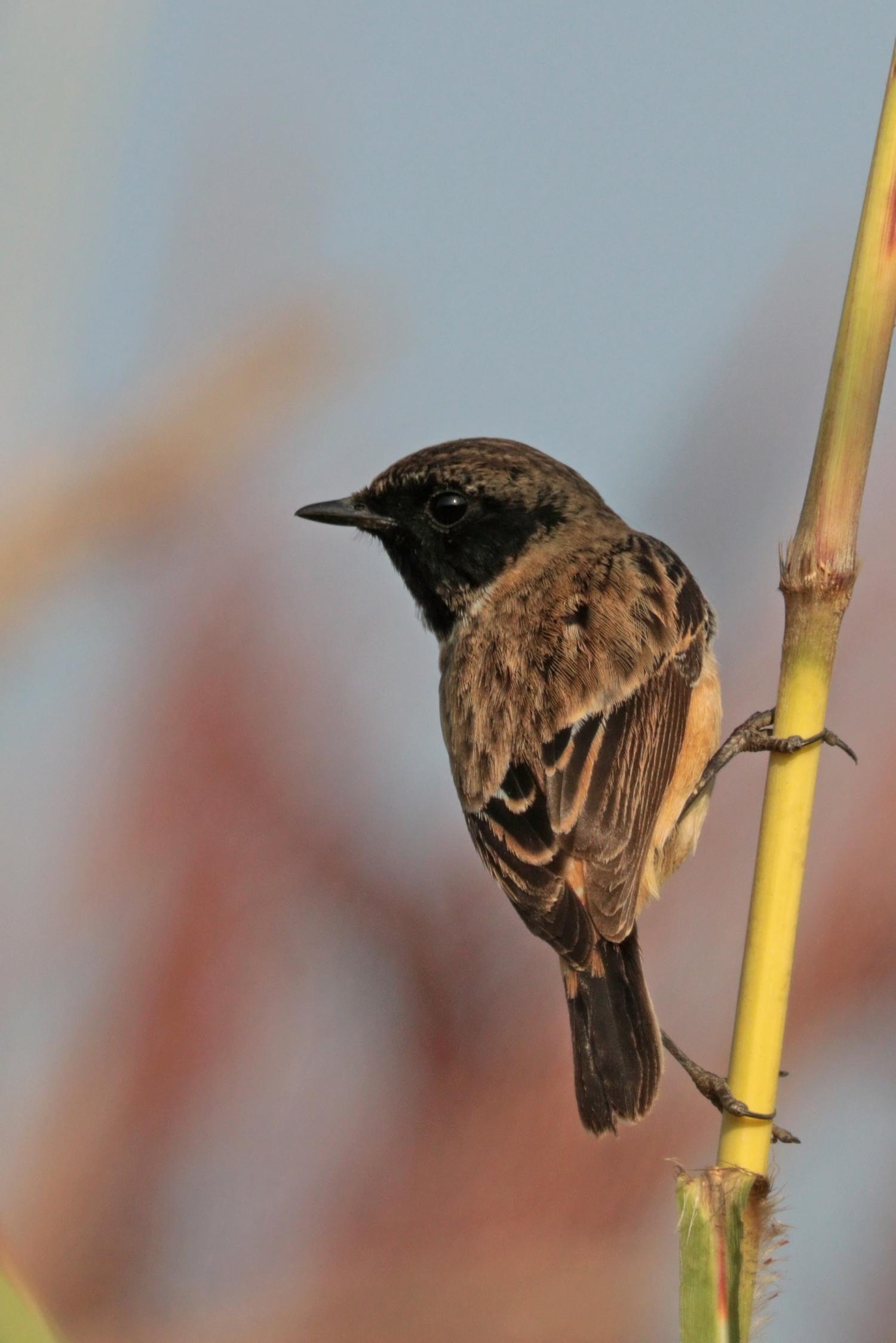Species of Thailand
Eastern stonechat
Saxicola maurus
Peter Simon Pallas, 1773
In Thai: นกยอดหญ้าหัวดำ
The Siberian stonechat or Asian stonechat (Saxicola maurus) is a recently validated species of the Old World flycatcher family (Muscicapidae). Like the other thrush-like flycatchers, it was often placed in the Turdidae in the past. It breeds in the East Palearctic including in easternmost Europe and winters in the Old World tropics.
Description, systematics and taxonomy
It resembles its closest living relative the European stonechat (S. rubicola), but is typically darker above and paler below, with a white rump and whiter underparts with less orange on the breast. The male in breeding plumage has black upperparts and head (lacking the brownish tones of the European stonechat), a conspicuous white collar, scapular patch and rump, and a restricted area of orange on the throat.
The female has pale brown upperparts and head, white neck patches (not a full collar), and a pale, unstreaked pinkish-yellow rump. Males in winter plumage are intermediate between summer males and females, with a supercilium resembling the whinchat (S. rubetra); from this species and the female it can be distinguished by the full white collar.
If seen at close distance, it can be recognized that its primary remiges are distinctly longer than in S. rubicola. In this, it closely resembles the whinchat, which like S. maurus is adapted to long-distance migrations.
The male has a clicking call, like two pebbles knocked together. The song is high and twittering like the dunnock (Prunella modularis), an unrelated passeridan songbird belonging to the Passeroidea.
There are five or six subspecies, with S. m. maurus (described above) and the distinct but similar S. m. stejnegeri found across northern and central Asia. The southern S. m. variegatus (west of the Caspian Sea), S. m. armenicus (eastern Turkey to Iran), S. m. indicus (Himalaya) and the Turkestan stonechat S. m. przewalskii (southwest China) are distinguished by larger white areas on the plumage.
In the past, S. maurus was usually included in S. torquatus as part of the "common stonechat", but that scientific name nowadays is restricted to the African stonechat. Analysis of mtDNA cytochrome b sequence and nDNA microsatellite fingerprinting data, though not unequivocal, together with the evidence from morphology, behaviour and biogeography seems to indicate that the present bird can be considered a distinct species. The European stonechat is its western sister species in the Eurasian lineage of stonechats; their ancestors separated during the Late Pliocene or Early Pleistocene, roughly 1.5-2.5 million years ago at the onset of the Quaternary glaciation.
Its scientific name means "dark rock-dweller". Saxicola derives from Latin saxum "rock" + incola "inhabitant"; maurus is Latinized from Greek maúros (μαύρος) "black" (cf. "moor"), in reference to the upperpart colour as compared to S. rubicola.
Distribution and ecology
The breeding range covers most of temperate Asia, from about latitude 71°N in Siberia south to the Himalaya and southwest China, and west to eastern Turkey and the Caspian Sea area. It also breeds in the far northeast of Europe, mainly in Russia but occasionally as far west as Finland.
The wintering range of the migratory bird is from southern Japan south to Thailand and India, and west to northeast Africa. On migration, small numbers reach as far west as western Europe, and exceptionally as far east as Alaska in North America.
The Siberian stonechat is insectivorous. It breeds in open rough scrubland or rough grassland with scattered shrubs, from sea level to about 4, 000 m ASL or more. The birds seem to avoid even cool temperate conditions and stay up north only during the hot continental summer. In the montane regions of the Himalaya foothills of Bhutan, migrants can on occasion be seen foraging in fields and pastures more than 2, 000 m ASL, but most move further down and south to winter in tropical regions.
Though it is not considered a distinct species by the IUCN, it is widespread and common and would not be considered a threatened species.
This article uses material from Wikipedia released under the Creative Commons Attribution-Share-Alike Licence 3.0. Eventual photos shown in this page may or may not be from Wikipedia, please see the license details for photos in photo by-lines.
Category / Seasonal Status
Wiki listed status (concerning Thai population): Resident and winter visitor
BCST Category: Recorded in an apparently wild state within the last 50 years
BCST Seasonal statuses:
- Non-breeding visitor
- Resident or presumed resident
Scientific classification
- Kingdom
- Animalia
- Phylum
- Chordata
- Class
- Aves
- Order
- Passeriformes
- Family
- Muscicapidae
- Genus
- Saxicola
- Species
- Saxicola maurus
Common names
- Thai: นกยอดหญ้าหัวดำ
Conservation status
Not Evaluated (IUCN3.1)
Photos
Please help us review the bird photos if wrong ones are used. We can be reached via our contact us page.
Range Map

- Chiang Saen District, Chiang Rai
- Doi Inthanon National Park
- Doi Lang
- Fang District, Chiang Mai
- Kaeng Krachan National Park
- Khao Yai National Park
- Mae Ping National Park
- Mae Wong National Park
- Non Thai District, Nakhon Ratchasima
- Pai District, Mae Hong Son
- Pak Phli District, Nakhon Nayok
- Pang Sida National Park
- Pha Daeng National Park
- Phu Hin Rong Kla National Park
- Phu Suan Sai National Park
- Surin Islands
- Thap Lan National Park

